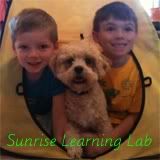Well, one of the things I had seen and had pinned was about making bouncy balls and learning about polymers.
Today, we decided to do just that...
We went over the steps in the Scientific Method.
We decided that we would make polymers and compare and contrast how our homemade polymer bouncy balls stacked up with store bought bouncy balls.
First, we observed the store bought balls.
The boys noted that the bouncy balls appear to have been made into halves and then, joined at a seam in the middle to make spheres.
We noted that they felt heavy, a little slippery, almost greasy.
We noted that the colors were uneven on each side of the ball.
Some parts of the ball appeared to be more solid / translucent while other parts appeared to be more transparent.
We noticed how heavy they felt.
The storebought bouncy balls were mostly smooth, but there were some slight ridges near the seams of the balls. The slightly rough ridges did not seem to impace the bouncy balls' performance.
All of the balls had similar results with respect to the height of each bounce.
We then followed the recipe for making the polymers.
The recipe called for using Elmer's glue, but did not specify which type of Elmer's to use.
We used one bottle of Elmer's Glue-All and one bottle of Elmer's School Glue.
For the first trial, Big Bro used the Elmer's Glue-All.
It had been mentioned in the comments section of the post that some suggested that Elmer's Glue-All works best, although that is not specified in the actual recipe.
We found that on the contrary, the Elmer's Glue-All did not work but that the Elmer's School Glue did work...interesting.
He chose to use blue food coloring gel to color his bouncy ball.
Little Bro used Elmer's School Glue. He used green food coloring gel to color his bouncy ball.
Both boys used warm water, although Big Bro's water appeared to be slightly warmer than Little Bro's water.
When the boys started to stir the mixture until it became hard for them to stir, at that point, the ball mixtures felt similar.
However, once Big Bro managed to get his initially into a ball shape, he decided to bounce it. The directions did not specify that you have to wait until the balls are entirely dry, but perhaps, that should be added in, as when Big Bro tried to bounce his ball, it split and then, would not roll back into a bouncy ball again. We even tried to put it back into the cup and we went back and tried to re-roll it, but without any success.
As Little Bro switched his mixture out from the cup, it began to form nicely into a fairly solid little ball.
The only thing was that as he would let his bouncy ball sit, it would flatten out a bit and become a little lopsided.
We decided that the store bought balls that were obviously made and kept in half moon shaped dies made them keep their shapes better.
If Little Bro could have had his bouncy ball in a mold, am pretty sure that it would have been a near perfect sphere.
Little Bro's bouncy ball did work reasonably well at bouncing when compared to the store bought bouncy ball.
So then, we decided to go back and re-visit the steps and the variables. Big Bro used slightly cooler warm water than he had before...he also switched to a combination of Elmer's and glitter glue.
Little Bro made a new batch of his polymer and this time, he also added some glitter glue to his bouncy ball concoction.
Both of the bouncy balls formed nicely. They felt considerably cooler to the touch and looked neat, as they were sparkly from all of the glitter glue that was used.
The balls look like perfect spheres when you roll them and knead them, but then, when you allow the bouncy balls to rest on the table, they kind of flatten out just a bit.
We discussed how sometimes things like this end up being a new product.
We brainstormed when there would be a need to have a bouncy surface but yet, not necessarily a perfectly spherical surface.
We discussed how tennis shoe bottoms would be an example of something like this...you want the surface to give and to be bouncy, but not especially round and solid, more flexible and ever changing as the person takes each step.
After cleaning up a bit from this study of polymers, we then talked about what is and what is not a polymer.
To contrast, we then made a batch of a version of dough that has been given the name cloud dough.
Again, we compared and contrasted two types of doughs with this...the one was made with the left over corn starch from the bouncy ball experiment. The other was made with traditional white flour.
Both used baby oil in their recipes.
The ratio of either cornstarch or flour to baby oil is supposed to be 8:1, so we did four cups of corn starch to 1/2 cup of baby oil and then, 4 cups of white flour to 1/2 cup of baby oil.
Big Bro did what the recipe calls for, the four cups of flour with the 1/2 cup of the baby oil.
Little Bro did the corn flour and baby oil mixture.
We felt the two and they felt very similar, although the corn starch mixture was lighter, airy feeling while the white flour cloud dough almost had a bit of a yellowish tinge to it.
Both of the boys then decided to combine their respective batches of cloud dough into one big plastic bin. The kitchen smelled just like that familiar baby powder fragrance from back in the day when they used to bathe in something that smelled similar...
After they both added their mixtures, they then thoroughly mixed them and then, they each took half of the new cloud dough, now our version of cloud dough.
They then decided that they wanted to add food coloring to their batches of cloud dough. Little Bro made yellow and red (which ended up looking like pink) and Big Bro decided to add both blue and green to his (ended up looking medium green).
All of the dough color of dough took on a speckled, robin's egg-ish sort of appearance, which looked really neat!
They had a great time with the cloud dough!
We talked about how this dough is different from a polymer in how the ingredients have combined.
The cells have not changed in the same fashion as how they did when they turned into a polymer with the bouncy ball recipe.
Big Bro is going to write up our findings in a science report, but right now, we are just cleaning up the mess in the kitchen!
Great fun, but if we do this again, would do it on the lanai or outside.
Wonderful, multi-sensory day for learning and exploring here!!!
Doesn't this cool photo by Jonathon Dunckley inspire you to wanna make bouncy balls and to learn about polymers too???
Thanks to Polymers Study: Random but Cool: How to Make Bouncy Balls...by Capreek on Curbly.com, with photo by Jonathon Dunckley, and to Anne Marie Helmenstine, Ph.D., from Ask.com, for inspiring us!
This is what inspired us to make the cloud dough with the remaining corn starch, plus flour, baby oil, and some food coloring.
Thanks to I Can Teach My Child for the inspiration!
Here are some photos we took today (Big Bro helped take these!)
Would love to see what you are up to in your home or classroom! Please feel free to leave a link if you have something fun and educational that you would like to share.
Update: We had a blast working with polymers! We did additional experiments so will do another polymer post soon...one thing to note: the bouncy balls we made worked well the day that we made them, although they were a little floppy, not perfect spheres, they still bounced.
But as they sat longer, they began to flatten. We then thought that perhaps if we let them sit out and air dry, that they would be perfect the nexct day. Well, not so...they got hard on the outside, and looked more like truffles, with a little flat part on the bottom.
They did not work well as bouncy balls the next day.
We still learned so much about polymers, so we will share more photos and info. about what else we did with polymers soon.

















.jpg)
.jpg)
.jpg)
.jpg)
.jpg)
.jpg)
.jpg)
.jpg)
.jpg)
.jpg)
.jpg)
.jpg)
.jpg)
.jpg)
.jpg)
.jpg)
.jpg)
.jpg)
.jpg)
.jpg)
.jpg)
.jpg)
.jpg)
.jpg)
.jpg)
.jpg)
.jpg)
.jpg)
.jpg)
.jpg)
.jpg)
.jpg)
.jpg)
.jpg)
.jpg)








.JPG)
.jpg)








